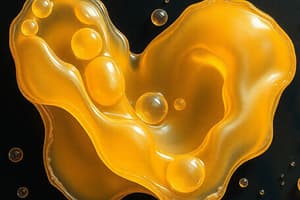Podcast
Questions and Answers
What initiator was used in the synthesis of chitosan-p(MAA-co-NIPAM) hydrogels?
What initiator was used in the synthesis of chitosan-p(MAA-co-NIPAM) hydrogels?
- Calcium chloride
- Sodium bicarbonate
- Ammonium persulfate (correct)
- Potassium sulfate
Which peak corresponds to the PMAA in the FTIR analysis?
Which peak corresponds to the PMAA in the FTIR analysis?
- 2930 cm−1
- 1155 cm−1
- 1648 cm−1
- 1716 cm−1 (correct)
What was the primary solvent used to dissolve chitosan in the preparation process?
What was the primary solvent used to dissolve chitosan in the preparation process?
- Diethyl ether
- Sodium hydroxide solution
- Glacial acetic acid (correct)
- Ethanol
What does the area between the baseline and the peak represent in FTIR results?
What does the area between the baseline and the peak represent in FTIR results?
What is the purpose of the ratio of peak area values in the study?
What is the purpose of the ratio of peak area values in the study?
At what resonance frequency was the solid-state 13 C NMR measurement carried out?
At what resonance frequency was the solid-state 13 C NMR measurement carried out?
Which component is NOT mentioned as part of the hydrogel synthesis process?
Which component is NOT mentioned as part of the hydrogel synthesis process?
What aspect of the hydrogels was assessed by measuring their zeta stability?
What aspect of the hydrogels was assessed by measuring their zeta stability?
What reaction time resulted in high zeta potential values?
What reaction time resulted in high zeta potential values?
What happens to the hydrodynamic diameter when the reaction time is extended from 120 min to 180 min?
What happens to the hydrodynamic diameter when the reaction time is extended from 120 min to 180 min?
What effect does increasing temperature have on the zeta potential?
What effect does increasing temperature have on the zeta potential?
How does the PNIPAM content affect the zeta potential at extended reaction times?
How does the PNIPAM content affect the zeta potential at extended reaction times?
What was the extent of the shrinkage diameter compared to maximum swelling observed?
What was the extent of the shrinkage diameter compared to maximum swelling observed?
What was the effect of ionization of PMAA on the stability of the hydrogels?
What was the effect of ionization of PMAA on the stability of the hydrogels?
What interaction was primarily broken due to increased temperature?
What interaction was primarily broken due to increased temperature?
At what reaction time is the hydrodynamic diameter smaller than that at the subsequent reaction time?
At what reaction time is the hydrodynamic diameter smaller than that at the subsequent reaction time?
What happens to the zeta potential as the pH increases above neutral levels?
What happens to the zeta potential as the pH increases above neutral levels?
What role does SPAN 80 play in the formation of hydrogels?
What role does SPAN 80 play in the formation of hydrogels?
How does reaction time affect the hydrogels synthesized for 30 minutes in terms of temperature stability?
How does reaction time affect the hydrogels synthesized for 30 minutes in terms of temperature stability?
How does increasing temperature affect the stability of the hydrogels?
How does increasing temperature affect the stability of the hydrogels?
What effect does extending the reaction time to 120 minutes have on the hydrogel structure?
What effect does extending the reaction time to 120 minutes have on the hydrogel structure?
What method was used to measure zeta potential in this study?
What method was used to measure zeta potential in this study?
Why does the zeta potential of hydrogels synthesized for 30 minutes appear high at low pH?
Why does the zeta potential of hydrogels synthesized for 30 minutes appear high at low pH?
How does the reaction time impact the size of hydrogels at elevated temperatures?
How does the reaction time impact the size of hydrogels at elevated temperatures?
What was the pH range examined for its effect on hydrogels?
What was the pH range examined for its effect on hydrogels?
What is the main reason for the decrease in zeta potential over prolonged reaction times?
What is the main reason for the decrease in zeta potential over prolonged reaction times?
After how long did the polymer grow and reach a limitation?
After how long did the polymer grow and reach a limitation?
What occurs when zeta potential is influenced by polymerization in various pH environments?
What occurs when zeta potential is influenced by polymerization in various pH environments?
What was the effect of varying pH and temperature on hydrogels?
What was the effect of varying pH and temperature on hydrogels?
What effect does the PMAA layer have on the structure of hydrogels at high pH?
What effect does the PMAA layer have on the structure of hydrogels at high pH?
What kind of filter was used for the diluted hydrogels?
What kind of filter was used for the diluted hydrogels?
What characteristic does the FTIR spectrum of chitosan display?
What characteristic does the FTIR spectrum of chitosan display?
What type of hydrogels is characterized by swelling behavior that is sensitive to both salt and pH?
What type of hydrogels is characterized by swelling behavior that is sensitive to both salt and pH?
Which compound is primarily associated with enhanced antibacterial effects when delivered through graphene nanosheets?
Which compound is primarily associated with enhanced antibacterial effects when delivered through graphene nanosheets?
What is an effect of comonomer hydrophilicity on the behavior of N-isopropylacrylamide copolymers?
What is an effect of comonomer hydrophilicity on the behavior of N-isopropylacrylamide copolymers?
What characteristic of the superabsorbent hydrogel composite made of cellulose nanofibrils is highlighted?
What characteristic of the superabsorbent hydrogel composite made of cellulose nanofibrils is highlighted?
What is the main function of poly(N-isopropylacrylamide-co-methacrylic acid) hydrogels in drug delivery?
What is the main function of poly(N-isopropylacrylamide-co-methacrylic acid) hydrogels in drug delivery?
Which modification technique is used for carrageenan to achieve superabsorbent properties?
Which modification technique is used for carrageenan to achieve superabsorbent properties?
Which polymer is involved in the creation of temperature-sensitive interpenetrating networks?
Which polymer is involved in the creation of temperature-sensitive interpenetrating networks?
What is the significance of the lower critical solution temperature in polymer applications?
What is the significance of the lower critical solution temperature in polymer applications?
What peaks in the FTIR spectra indicate the presence of carbonyl groups in the chitosan-p(MAA-co-NIPAM) hydrogels?
What peaks in the FTIR spectra indicate the presence of carbonyl groups in the chitosan-p(MAA-co-NIPAM) hydrogels?
What type of bond stretching is indicated by the peak associated with primary amines in the chitosan?
What type of bond stretching is indicated by the peak associated with primary amines in the chitosan?
Which chemical groups show peaks in the region between 1700–1740 cm−1 in the FTIR spectra?
Which chemical groups show peaks in the region between 1700–1740 cm−1 in the FTIR spectra?
At which peak do the C–H bending vibrations appear in the FTIR spectra of chitosan?
At which peak do the C–H bending vibrations appear in the FTIR spectra of chitosan?
What is the significance of the peaks at 1638 and 1619 cm−1 in the FTIR analysis?
What is the significance of the peaks at 1638 and 1619 cm−1 in the FTIR analysis?
During the formation of the chitosan-p(MAA-co-NIPAM) hydrogels, how long did the reaction take before significant results were observable?
During the formation of the chitosan-p(MAA-co-NIPAM) hydrogels, how long did the reaction take before significant results were observable?
Which of the following pairs of components are involved in the synthesis of chitosan-p(MAA-co-NIPAM) hydrogels?
Which of the following pairs of components are involved in the synthesis of chitosan-p(MAA-co-NIPAM) hydrogels?
Which of the following statements concerning the hydrogel structure post-reaction is correct?
Which of the following statements concerning the hydrogel structure post-reaction is correct?
Flashcards
Hydrogels Preparation
Hydrogels Preparation
Hydrogels were synthesized by copolymerizing chitosan, MAA, NIPAM, and MBA using ammonium persulfate as an initiator.
Spectrometer Analysis
Spectrometer Analysis
Material samples were analyzed using a spectrometer to identify and quantify components.
FTIR Analysis
FTIR Analysis
FTIR analysis provided information about the relative changes in different components in the hydrogel by analyzing the peak areas of various molecules.
13C NMR Measurement
13C NMR Measurement
Signup and view all the flashcards
Chitosan Dissolving
Chitosan Dissolving
Signup and view all the flashcards
Freeze-dried Hydrogels
Freeze-dried Hydrogels
Signup and view all the flashcards
Spectra/Por Membrane
Spectra/Por Membrane
Signup and view all the flashcards
Component Ratios
Component Ratios
Signup and view all the flashcards
Zeta Potential
Zeta Potential
Signup and view all the flashcards
Zeta Potential Measurement
Zeta Potential Measurement
Signup and view all the flashcards
Temperature's Effect on Zeta Potential
Temperature's Effect on Zeta Potential
Signup and view all the flashcards
pH's Effect on Zeta Potential
pH's Effect on Zeta Potential
Signup and view all the flashcards
SPAN 80's Role
SPAN 80's Role
Signup and view all the flashcards
Hydrogels' Swelling Behavior
Hydrogels' Swelling Behavior
Signup and view all the flashcards
FTIR Spectroscopy
FTIR Spectroscopy
Signup and view all the flashcards
FTIR's Significance for Hydrogels
FTIR's Significance for Hydrogels
Signup and view all the flashcards
Hydrogels
Hydrogels
Signup and view all the flashcards
Chitosan-p(MAA-co-NIPAM) Hydrogels
Chitosan-p(MAA-co-NIPAM) Hydrogels
Signup and view all the flashcards
C=O stretching vibration
C=O stretching vibration
Signup and view all the flashcards
C-H bending vibration
C-H bending vibration
Signup and view all the flashcards
MAA in Hydrogels
MAA in Hydrogels
Signup and view all the flashcards
NIPAM in Hydrogels
NIPAM in Hydrogels
Signup and view all the flashcards
Cross-linking in Hydrogels
Cross-linking in Hydrogels
Signup and view all the flashcards
Hydrogel Swelling
Hydrogel Swelling
Signup and view all the flashcards
Cross-linking and Swelling
Cross-linking and Swelling
Signup and view all the flashcards
Reaction Time's Impact
Reaction Time's Impact
Signup and view all the flashcards
Electrostatic Repulsion
Electrostatic Repulsion
Signup and view all the flashcards
Collapse Temperature
Collapse Temperature
Signup and view all the flashcards
Hydrodynamic diameter
Hydrodynamic diameter
Signup and view all the flashcards
PNIPAM content
PNIPAM content
Signup and view all the flashcards
Ionization of PMAA
Ionization of PMAA
Signup and view all the flashcards
Hydrogen bond breaking
Hydrogen bond breaking
Signup and view all the flashcards
Shrinkage diameter
Shrinkage diameter
Signup and view all the flashcards
Temperature's effect on swelling
Temperature's effect on swelling
Signup and view all the flashcards
Zeta potential and swelling
Zeta potential and swelling
Signup and view all the flashcards
What are hydrogels?
What are hydrogels?
Signup and view all the flashcards
What is chitosan?
What is chitosan?
Signup and view all the flashcards
What is MAA?
What is MAA?
Signup and view all the flashcards
What is NIPAM?
What is NIPAM?
Signup and view all the flashcards
What is cross-linking in hydrogels?
What is cross-linking in hydrogels?
Signup and view all the flashcards
Why is zeta potential important for hydrogels?
Why is zeta potential important for hydrogels?
Signup and view all the flashcards
How does temperature affect hydrogels?
How does temperature affect hydrogels?
Signup and view all the flashcards
How does pH affect hydrogels?
How does pH affect hydrogels?
Signup and view all the flashcards
Study Notes
Synthesis and Evaluation of pH- and Temperature-Responsive Chitosan-p(MAA-co-NIPAM) Hydrogels
- Chitosan-poly(methacrylic acid-co-N-isopropylacrylamide) [chitosan-p(MAA-co-NIPAM)] hydrogels were synthesized via emulsion polymerization.
- The hydrogels are designed to be biocompatible, biodegradable, and multi-responsive, making them suitable for drug delivery systems.
- Copolymerization of MAA and NIPAM with chitosan creates the chitosan-based hydrogel.
- Fourier transform infra-red (FTIR) spectroscopy confirmed successful hydrogel production.
- PNIPAM coating on the hydrogel influenced its stability during synthesis.
- Chitosan and PMAA increased the hydrogel's zeta potential.
- Chitosan controls hydrogel shrinkage above body temperature.
- The hydrogels respond to both pH and temperature, enhancing their performance as drug carriers.
Introduction
- Hydrogels are materials that absorb water in response to physical, chemical, or biochemical stimuli.
- They are used as drug carriers due to their extended duration in the body without substantial health risks.
- Chitosan, a natural polymer, is utilized for its biodegradability and biocompatibility.
- Chitosan is modified by crosslinking to create pH and temperature sensitivity to enhance drug delivery performance.
- Crosslinking chitosan with PNIPAM results in hydrogels with low toxicity, and tailored drug release profiles.
- Chitosan crosslinked with PMAA hydrogels respond to ionic strength variations (osmotic pressure).
Experimental
- Materials such as NIPAM, MBA, chitosan, Span 80, and acetic acid were used.
- Chitosan-p(MAA-co-NIPAM) hydrogels were synthesized using emulsion polymerization with ammonium persulfate (APS) as an initiator.
- The procedure involved controlled dissolution of chitosan, addition of MAA and NIPAM, and addition of crosslinker (MBA) and emulsifier (Span 80).
- Various reaction times (RT30, RT60, RT120, RT180) were used to investigate the synthesis process.
- Freeze-drying and dialysis purified the synthesized hydrogels.
Hydrogel Characterization
- Field emission scanning electron microscopy (FESEM) examined the morphology.
- Fourier transform infrared spectroscopy (FTIR) identified functional groups within the hydrogels.
- Fourier transform infrared spectroscopy (FTIR) was used to investigate the interaction between different monomers such as PMAA, PNIPAM and chitosan throughout the reaction.
- 13C Nuclear Magnetic Resonance (13C NMR) analysis confirmed the incorporation of MAA, PNIPAM and chitosan.
Response to pH and Temperature
- Zeta potential measurements evaluated the stability at various pH values (1.68, 4.01, 7.4, 10.01).
- Zeta potential measurements also examined the effect of temperature variations from 25°C to 55°C.
- Dynamic light scattering (DLS) measured the swelling/de-swelling behavior of hydrogels at different pH values.
- Swelling/de-swelling behavior was studied at 37°C with dynamic light scattering (DLS).
- Volume phase transition temperature (VPTT) was investigated to understand temperature-dependent properties.
Conclusions
- Emulsion polymerization successfully synthesized chitosan-p(MAA-co-NIPAM) hydrogels.
- Reaction time significantly affected the hydrogel structure and properties; suitable reaction times were identified.
- Hydrogel structure was altered by extending the reaction time; controlled ratios of MAA, PNIPAM, and chitosan were established.
- The hydrogels exhibited responsive behavior to pH and temperature changes.
- The hydrogels have potential application as drug delivery carriers.
Studying That Suits You
Use AI to generate personalized quizzes and flashcards to suit your learning preferences.




